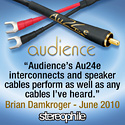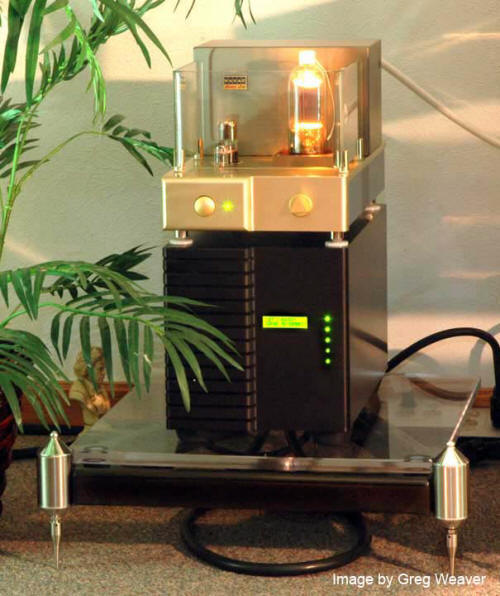From the beginning
This remarkably musical tale begins some
four years ago now: First envisioned in January 2007 during the historic
fortieth CES (and the first to be held in The Venetian), at the
site of the Richard Beer's highly successful companion T.H.E. Show
held at the St. Tropez. That was my first real opportunity to hear,
rather than just hear about, WAVAC amplification. The amps in play that
day were the (then) $150,000/pair HE-833 Mk II. They are the four-box
little sibling to WAVACs flagship eight-box, $350,000 SH-833. No, you
read that correctly, I said just over a third of a million dollars.
On that visit to room 1604 of the St. Tropez
campus, the utter immediacy and control of the system in play
overwhelmed me. The resultant sound in that room was so very close to
pure music that it was almost frightening. To say that the experience
superseded the expectation still wouldn't give you a sense of just how
good it really was. I could not recall having heard a piano
reproduced with such percussive accuracy, so rich in tonal texture, and
so vibrantly alive in its own space. It was as close to the sound of a
real piano being played in a live space as I had ever heard from
any electro-mechanical system up to that point, period. Then again, with
a total system price of half a million bucks, you'd expect something
that memorable, wouldn't you?
Once my
2007 CES report published, I was inspired to send a cold call
directly to WAVAC, asking if they might consider allowing me to examine
the top of their 805 power tube series, the MD-805 Mk II monoblocks.
Imagine my great delight when Jonathan Brown, principal and all-round
good guy at Covenant Audio Consulting, responded affirmatively to my
request less than a month after the show.
Jonathon is a NASA engineer and seasoned
audiophile of over 20 years. By day, he is the Branch Chief for Flight
Assurance, and is responsible for system safety and software assurance
for aeronautics programs and projects at NASA Dryden; he also enjoys the
privilege of being the US Distributor of WAVAC Audio Labs products. His
message indicated that he would be happy to facilitate my auditioning of
the MD-805 MkII, just subjected to a 10th Anniversary
treatment. As these are rather rare beasties, only built to order, given
their build cycle of 45 to 60 days it would take some time to put the
plan together.
Though a ship date of April 1, 2007 was
originally planned, shipping damage and further unrelated business
issues stayed the project for what came to seem like forever. However,
after visiting Jonathan in the WAVAC room at 2009'sT.H.E. Show
held in the Alexis park, the old site for the CES' so-called High
Performance Audio exhibits, I was comfortably and confidently assured
that he still wanted me to do the review, and that they would ship early
that year. Having had the pleasure of getting to know him through many
correspondences and our mutual fascination with feudal Japan, it was
with unbridled excitement that I maneuvered the five package shipment
into my basement listening room the last day of February 2009. Sidelined
by some major damage to my left shoulder in early May of that year,
undergoing full open Rotator Cuff corrective surgery that July, then
rehabbing my arm, the project suffered even further setbacks of yet
another five or six months. However, what follows, dear readers, is the
chronicle of one music lover's privileged trip into splendid excess at
the gracious hands of the melodic necromancers of WAVAC Audio Labs.
History
WAVAC Audio Labs come into being in 1994
when Yasuo Yoshizawa, the executive director of the former Yoshiki
Industry Co., stumbled upon the book "Production of Single Amplifier"
written by the late Nobu Shisido. Mr. Yoshizawa was so taken by the read
that he sought out Mr. Shisido at his home, and the two rapidly
developed a friendship, one that blossomed into a project to develop and
produce tube amplifiers.
Though the circuit was the brainchild of Mr.
Shishido and the chassis was the result of the efforts of Mr. Yoshizawa,
the company eventually grew to include a development staff which
included Yuzuru Ito, a stage, sound effect, and recording engineer,
Yasunori Matsuki and Masakuni Kudo. One of the earliest identified goals
of the company was to create a large output tube amplifier to drive
today's modern, more moderate to low-efficient loudspeakers easily, not
just to recreate yet another good nostalgic tube amp.
In March of 1998, when Mr. Shishido abruptly
passed away, Yuzuru Ito took up the reins of the company and followed
his tradition, continuing to develop fine tube based products.
In October of 1999, Sigma Co., Ltd, the
large Japanese industrial firm where Mr. Ito is a Vice President, took
over the development, production, and sales sections of WAVAC Audio Lab
from Yoshiki Industry Co., and the sale/joint venture provided
additional funds for growth and expansion. However, by 2004, as soon as was practical for WAVAC to financially
stand on its own, Mr. Ito was able to make that a reality, which it is
to this day.
Hardware
Five packages landed here in all; four at
nearly seven and a half cubic feet (21" x 21" x 29") each, housing the
pair of amplifiers and their two respective power supplies, and one much
smaller (and lighter), full of valves. All told, with a combined
shipping weight over 320 pounds, my delivery driver was only too happy
to have my assistance unloading my prizes.
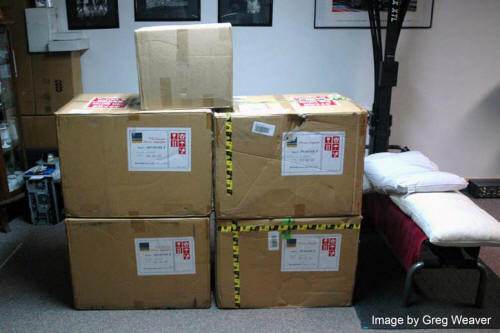
Five boxes of audiophile heaven
Once the quintet of boxes made it into my
listening room, the REAL fun began. Jonathan had taken the added
precaution of inserting some customized Styrofoam and plastic spacers
inside the power supply chassis' to prevent any shifting, loosening, or
other untoward damage to the numerous transformers inside the sturdy
bodywork during shipment. After taking a few minutes to figure out how
to loosen the top plate, I was able to extract that extra material and
get the enormous power supplies ready to go. Unpacking them, situating
them on my Grand Prix Audio Monaco Amplifier stands, connecting them,
and preliminary start-up required the better part of an hour and an half
of solid schlepping and toting.
The core of the MD-805 Mk II, as its name
implies, is a sole, single-ended, directly heated 805 high power triode
transmitter tube. With a filament voltage and current capability of 10
volts and 3.25 amps, the 805 transmitter tube is likely one of the most
powerful single device available for SET designs (the 833 has the same
voltage, but draws 10 amps!). If you are unfamiliar with that tube,
don't worry, I'm sure you won't be alone. While I can think of other
amps that are built around the 805, like the $4750 per pair Antique
Sound Lab Explorer 805 DT, they are not that popular. WAVAC also
employs a 6Y6GT driver tube and a 5751 input tube. Not a common
configuration, to say the least.
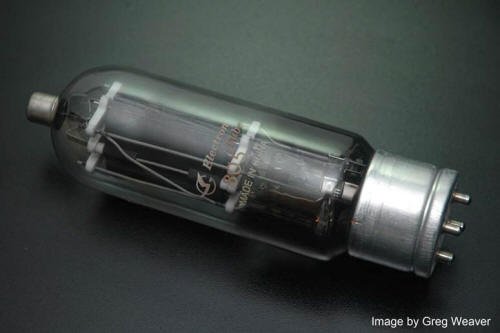
The stock Chinese 805 power tube
As shipped from WAVAC, the MD-805 Mk II uses
current production, Chinese sourced tubes. As such, these tubes are both
in stock and seem to be readily available. The bulk of my evaluation saw
the supplied stock tubes in place. Not to fear tube rollers, there is
more on that subject to come.
The phrase "thoriated tungsten filaments,"
used to describe their 805 tubes in the WAVAC literature, found me doing
a bit of research. "Thorium dioxide is used as a stabilizer in
tungsten electrodes in TIG welding, electron tubes, and aircraft
engines. As an alloy, thoriated tungsten metal is not easily deformed
because the high fusion material thoria augments the high temperature
mechanical properties, and thorium helps stimulate the emission of
electrons (thermions). It is the most popular oxide additive because of
its low cost, but is being phased out in favor of non-radioactive
elements such as cerium, lanthanum, rhenium, and zirconium."
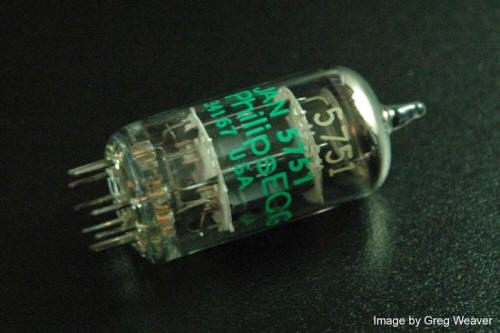
The stock 5751 input tube
That bit about its "…being phased out in
favor of non-radioactive elements such as cerium, lanthanum, rhenium,
and zirconium…" led me to do just a tad more research. Though
commonly used in light bulb filaments for decades (now most commonly
replaced by rhenium), potential doses are ridiculously low. The U.S.
Nuclear Regulatory Commission calculated an effective dose equivalent to
less than 0.001 mrem per year for an individual spending eight
hours per day at one meter from a lamp employing a thoriated tungsten
filament and 20 hours per day at two meters from two such light bulbs.
Compare this with an annual average exposure of approximately 300 mrem
due to natural background radiation. No worries, mate. In a nutshell, it
is used to afford longevity to the filament of the tube.
Described as being bullet proof, the 6Y6GT
Beam Power Tetrode driver tube is a common power supply driver tube for
amplifiers in which the plate voltage available for the output stage is
relatively low or in radio frequency-operated, high-voltage power
supplies, like those in television or radio transmission equipment. At
this point, if you've gotten the impression that the MD-805 Mk II
employs a beefy power supply, you'd be correct.
The MD-805 Mk II offers what I see as not
only a logical, but a truly inspired use of the 5751 dual triode input
tube. Where many other amps (the aforementioned Antique Sound Lab
Explorer DT, for example) uses what many find to be a harsher, more
hollow sounding 12AX7, WAVAC elected to use the 5751 for its improved
clarity, texture, tonal color, smoothness, and lower noise floor. While
only offering about 70 percent of the gain of a 12AX7, it is not
uncommon to find 5751s employed in high gain guitar amps, as musicians
tend to prefer its more classic "crunch" and effortlessness. While the
term "palpable" is unquestionably overused in audiophile journalism,
please forgive me its use here, as it truly is the ideal descriptive
adjective for the sonic enrichments afforded by the 5751 tube.
The Boxes
So, what makes the WAVAC design and
resultant sound so distinctive? Most is the result of the unique circuit
design, one formed around a theory originally envisioned by the late Mr.
Shishido and patented in 1995. Called the Inverted Interstage
Transformer Circuit (or IITC for short), it is describe as "the combined
circuit of electric tubes using a transformer."
While I have a strong engineering and
electronics background, the Japanese to American English translations
made available to me on the subject proved to be, well, let's just say
that they were less than helpful in aiding my comprehension of the
circuit design. I will leave it to the adventurous among you to research
this circuit on your own, should the mood strike you.
The four-box amplification system is
remarkable impressive, even before you light them up and listen.
Left and right channel components are identical, not mirror images of
each other, consisting of a 90 pound, 10 ¼" wide by 18 ¼" deep by 11 ½"
tall black power supply and a 55 pound, 10 ¼" wide by 18 ¼" deep by 10
¾" tall champagne colored amplifier per side.
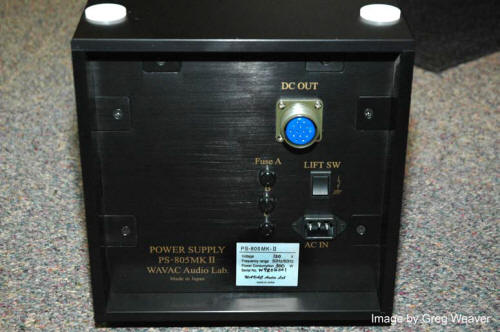
The back of the MD-805 Mk II power
supply, showing the fuse holders, IEC socket, ground lift switch and the
HUGE 14-pin connector to carry DC power to the amplifier. You can
clearly see two for the four "receivers" for the amp, which rests atop
the supply in use
The enormous black power supplies for each
channel are a marvel, hosing the substantial primary transformer, as
well as the additional B and C transformers, isolating them from the
amplification stage, and offering greater protection from magnetic
affects. The B power circuit employs a special double choke transformer
in hopes of further reducing induced hum. All the transformers are
mechanically isolated, both from the case and from each other, by a
material WAVAC calls Al fur gel. I'm sorry to say that I was able to
learn nothing more about the material.
The back of the Power Supply houses three
fuse holders, an IEC socket for the power cable, a ground lift switch,
and the huge 14-pin DC connector for the power umbilical to connect to
the amplifier. The front of the supply has a rectangular green Status
LCD display, as well as a set of 5 vertically placed green LEDs. During
the 60 seconds it takes to fully power up, the LED displays a digital
countdown, and the LEDs light up in sequence, from top to bottom,
indicating the start up status as well. Finally, located in each of the
four corners on the top of the supply are four shallow disc "receivers,"
which appear to be fabricated of white Teflon™, for the four feet of the
amplifier, which rests on top of the supply when in use.
The elegant alumite (a surface finishing
process, similar to anodizing) finished Champaign-colored amplifier
housing includes Teflon sockets for all three tubes. The shallow front
panel reveals a large round power push button switch as well as an input
volume control with a triangular knob, aiding in the ease of visually
matching knob settings between the two amps. The "tube cage" employed is
a unique shaped piece of glass. When looked at from the top, it is a U
shaped form that, when in place on its edge (on plastic stand-offs) on
top of the front of the amp, stylishly shields the tubes from the odd
inadvertent touch.
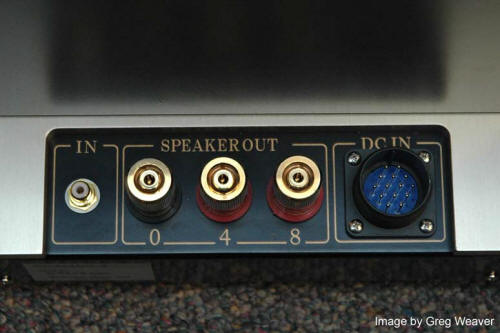
The connections on the amplifier,
single-ended input, 0, 4Ω, and 8Ω speaker taps, and the 14-pin DC power
input
All connections to the amplifier are mounted
on the top surface of the very back of the amp. From left to right,
looking at the back, you have the single-ended input, next are three
large speaker posts (0, 4Ω, and 8Ω taps), and then the mating 14-pin DC
connector to receive the DC umbilical from the power supply.
DC power is delivered from power supply to
amplifier via an enormous 2½" thick umbilical cable terminated at both
ends with threaded industrial plugs which appear to be manufactured by
ITT/Canon. After connecting my preamp to the single-ended inputs with my
Stealth INDRAs, tightening down the Von Schweikert Master Built
Signature Bi-wire speaker cables, and then installing my favorite IEC
power cables, it was time to press the power button and see what these
puppies could do.
The Sound of One Hand Clapping, Revealed
I should make it clear that I am not a blind
"toob" devotee; in fact, quite the opposite is true. While I readily
acknowledge that both tube and transistor designs each possess their own
unique métiers, strengths, problems, and faults, I just as freely reveal
that, overall, when employing today's multi-driver, complex impedance
loudspeaker systems, I find the faults of solid-state amplifier designs
less musically compromising than those of valve design – typically!
That is not to say that there are not some spectacularly effective tube
designs out there. Tim de Paravicini, Ralph Karsten, and Vladimir Lamm,
to name but a few, exemplify, to my mind, some of the more gifted
designers who have realized some of the most effective results. However,
I still find MANY highly regarded tube designs afford an overly round,
warm, bloated, and syrupy sound that tends to "editorialize" and "euphoricise"
the resultant sound, especially in the upper bass-lower midrange
regions.
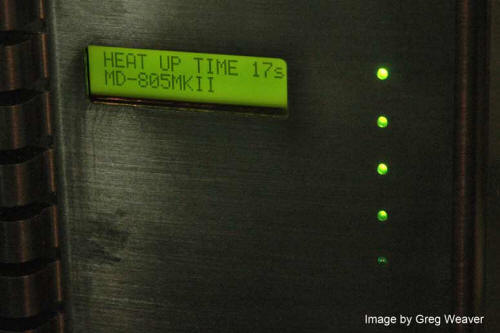
A close look at the integrated display
showing the time left until the tube voltage has stabilized and they
come out of protection.
Deep bass pitch definition has regularly
been an area where the lion's share of affordable tube offerings have
left me wanting. Now, don't take my statement as general disparagement
of all valve re-created bass; that would be a mistake. Honestly,
some of the most tuneful and realistic sounding bass I've ever
heard has been at the pleasure of valves.
Further, tube amplification traditionally
offers relatively low power output (sub 100-watt devices rarely are able
to "light my fire") as well. This is such an issue, that I will not even
broach the subject of the bevy of infinitesimally small, single-digit
watt output SET amps.
It is the synergy of these comparatively
consistent shortcomings that has conspired to keep the majority of tube
amplifiers off my lust lists. Well music lovers, I'm here to tell you
that Jonathan Brown and WAVAC have managed to change my mind—completely.
Given my previous preamble, I feel compelled
to start with bass performance, which, as I've suggested, has long been
a serious point of contention for me (and other like-minded music
lovers) with many—not all—tubed designs. I had more than one visitor to
my listening room during their extended stay (due to my shoulder
surgery) that seemed to think they were somehow lacking in the bass
department. I can assure you this is NOT the case. Some of these
listeners appeared to be easily confused; their general impression was
that sheer amplitude equates with quality of low frequency
information. Sad, but something I've run into more often than I'd care
to discuss.
I'm just going to say it; the MD-805 Mk II
monos deliver the most articulate, detailed, deepest, and
accurately pitch defined bass I've ever experienced from any
amplifier in my home, let alone one of the 60-Wpc variety! They exhibit
and define the leading edge of bass transients in an especially lifelike
way, one that many respected amplifiers would do well to emulate, if
only they could.
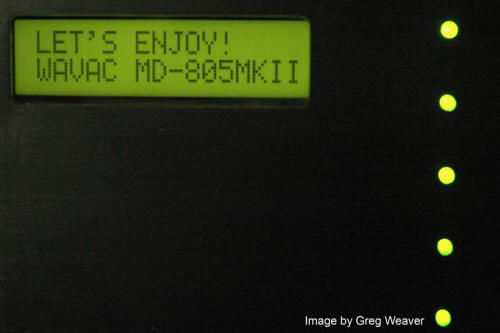
Once out of the warm up stage, this
displayed message says it all!
As you might expect, the midrange was
exquisite. These amps simply breathe life into and through out
the mids and lower treble, with no hint of editorialization or
addition of any euphonic color. Rather, they almost seem to celebrate in
recovering indolent vocal pauses, articulating enunciation and breathing
artifacts, and serving up any other form of realistic vocal construction
with which they are challenged. All the myriad nuances of the human
voice are reproduced so tangibly as to leave me wondering why ALL
amplifiers couldn't be this involving.
Treble, especially lower and mid-treble, was
gloriously fleshed out, replete with meticulous detail, definition, and
decay. The trailing edge of triangle strikes lingered on for 10's of
seconds when the recording permitted. Uppermost treble was so cleanly
portrayed, clearly, with exquisite detail, and in an unusually truthful
and recognizable manner, if not as fully extended as with the best
solid-state designs.
One of my first utterly transfixing experiences with these magnificent
behemoths in place came with Little Earthquakes [Atlantic
82358-2], the 1992 release from Tori Amos. The experience was near
religious. Their ability to reveal the nuanced textures and shades of
inflection in Tori's voice, to uncover and deliver up the subtleties and
evocations of her lyrical style, afforded an unprecedented exposure to
the meaning and tendered a clearer understanding on the stories behind
this unique songwriters works. They simply gave life to them by
seemingly divulging more of the artist's intention and meaning than I've
ever experienced from that recording in all the years I've been
listening to it.
Their ability to reconstruct the space of a
recording, synergizing with the inherent abilities of my reference Von
Schweikert VR-5 Anniversary loudspeakers, was nothing short of
exquisite. The space recreated in my room during the opening of the title
cut from Dire Straits 1985 masterpiece, Brothers in Arms [JVC
XRCD5483572], and the entirety of Roger Water's Amused to
Death [Sony/Columbia
CK53196] was
5.1-channel surround-like and downright haunting! It was as though the
physical boundaries of my listening room had melted away in the eerie
glow of these enchanting 805s, giving way to a much larger, more open
space.
Listing to the delectable SACD of Elton
John's 1971 release Tumbleweed Connection [Island Rocket
B0003611-36], the cut "My Fathers Gun" has a haunting solo guitar that
noodles in and out all throughout the track. With many amps, that solo
guitar is delicately tied to the right speaker. With the MD-805 Mk IIs
in place, that guitar was now floating outside the physical location of
the right speaker by several inches. And not only were the strings as
liquid and creamy sounding as I've ever heard, but the body of the
instrument was more realistically sized as well. Moving on to the cut
"Love Song," there was the overwhelming sense that there was simply
nothing coming from the speakers; I was left with only the music,
magical voices and instruments, occupying a different space and time in
my room.
One of my all-time favorite classical
records is the 1972 Sir George Solti/Chicago Symphony Orchestra version
of Beethoven's 9th Symphony. While I do have a 2-disc UK
Import Decca/London copy, I happen to have the Mobile Fidelity,
two-record release [MFSL2-516].
While this is far from a perfect audiophile recording, the individuality
of instruments was presented in a breathtaking fashion, both in the
utter clarity of their phrasing and the specificity of their individual
placement. The WAVACs afforded a heightened degree of musical
expression, illuminated instrumental lines more clearly, with better
demarcation, yet at the same time, offering a more effectively interwoven
musical tapestry from those discrete voices.
Tympani skin tone and impact was unlike I
can ever recall from this recording, one that I have heard literally
hundreds of times. Horns were rendered with a creaminess more akin to
what you hear in a good hall than from a great record. Smaller strings
took on more of that silky texture, while cellos and double basses were
more full-bodied, resonant, and woody sounding. This all lead to a
greater communication of the underlying musical message. It was one of
the most deeply moving experiences I've ever had in front of an
electro-mechanical aural illusion engine!
You may recall my previously stated concerns
about amplifiers in the sub 100-Wpc range, so this merits some
discussion. I am fond of "realistic" playback levels. That means that
whether I'm listening to full scale orchestral Classical or some
seriously electric Progressive Rock, I expect my system to hit 95 - 98 dB
peaks when called upon.
I'll freely admit that these may not
be the amps of choice for those who solely listen to Techno, Rave, Club,
or similar bass heavy genres, and want +100 dB SPLs in their room. I can
say that, with my Von Schweikert VR-5 Anniversaries (94 dB @ 1w/1m using
2.83v), and in my room, the WAVAC MD-805 Mk IIs delivered the sonic
goods, across all the genre's I fed them, consistently. In this exalted
application, it is my honest assessment that the MD-805 MKIIs offer
sufficient power and dynamic reserves for most traditional American
audiophiles.
Tube Rolling
Tube rollers, take heart, and pay attention.
Jonathan was kind enough to send along some NOS 1950's GE made 5751s and
a set of Radiotron RCA VT-143s (805s) stamped March 1943 (can you see me
drooling in anticipation?).
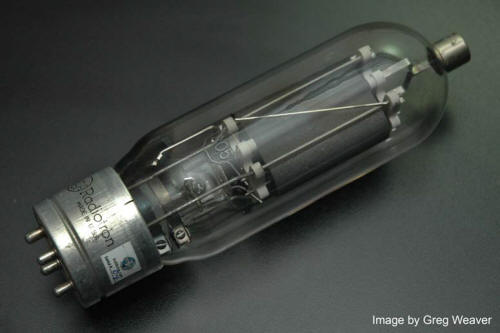
The well travel, Kühl-Tube cryogenically
treated NOS RCA VT-143s
Both sets of NOS tubes traveled to Tube
World and were subjected to the Kühl-Tube Cryogenic Treatment. While a
new 805 triode may be had for as little as a single Ben Franklin each,
the Kühl-Tube cryo treated NOS units run more like a grand a pair. The
5751s are a bit more reasonable, with new ones sourced for less than an
Andrew Jackson, while a pair of the Kühl-Tube cryo treated NOS units
cost just a tad over a single Ben Franklin.
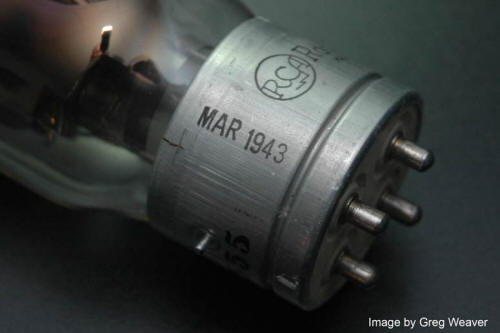
When these tubes were manufactured, Japan
was starting to lose the war in the Pacific and there was a failed
murder attempt on Adolf Hitler!
With the cryo-ed NOS 5751 input and VT-143
power tubes in place of the stock Chinese fare, the magic, along with
the tiny hairs on the back of my neck, went up—way up! In virtually
every category, harmonic texture, spatial recreation, tonal color, there
was more, and I mean clearly and noticeably MORE!
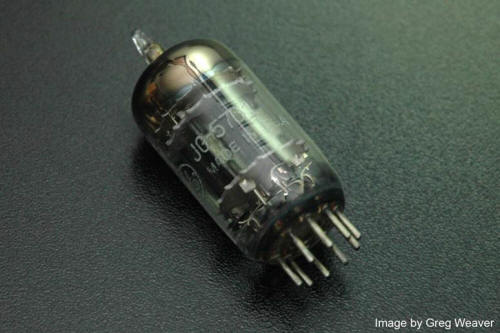
Cryo treated 1950's NOS GE 5751
I don't think anyone would try to argue that
a thousand dollars is cheap, even for a set of matched, cryo-treated,
NOS 805s. But, in the larger scheme here, if you have the $56 grand to
opt into these seductive amps, is $57 grand going to be a deal breaker?
Not very likely, eh? And what an addition they afford! This option is
not to be overlooked if you delve into this luxuriant territory.
The Magic of WAVAC
With the creation of the MD-805 Mk II, WAVAC
has managed to forge iron and glass into something akin to pure magic.
It is quite possible that mere mortals are undeserving of such music
rendering devices; I'm referring to those audiophile's whose quest is
the pursuit of yet the latest and greatest new device rather than the
latest and greatest recording. These devices are lovingly and magically
crafted for the true music lover among us, for they reveal a glimpse of
the inner soul and motivation of the singer, songwriter, or composer
under their charm.
While we could spend countless hours debating the definition and the
attributes of the term accuracy, I'll leave that discussion to those who
seem to value measurement over expression. While I cannot simply
disregard the value of metrics and their resultant subjective
informative value, I have no particular use for those measurements
alone, out of context, as some sole indicator of a components value or
worth. To me, the facility for a component to express the tenor and
passion of the artist unfailingly, to afford that heightened degree of
communicative ability, in a manner that consistently moves me as a
listener, is both the ultimate achievement and an elusive goal.
These amplifiers, in a manner and to a
degree which I've never come close to experiencing in my home prior,
deliver the pure and simple musical truth…an unquestioned,
indisputable, inescapable, enlightening, and noble musical genuineness.
They are quite simply the most musically expressive, emotionally
involving amplifiers I've had the pleasure to experience in my home.
If you have the coin, you owe it to yourself
to revel in the musical voice of these stunning looking, and even more
stunning sounding, music makers. These mono's are most enthusiastically
recommended for the well-heeled music lovers among you. Greg Weaver
WAVAC Audio Labs 805-Mk II 10th
Anniversary Edition Amplifiers
Retail: $55,900/pr. Serial Numbers of Evaluation Units –
W7Z0K000/1
WAVAC
web address:
www.wavac-audio.jp/index.shtml
US Distributor
Covenant Audio
web address:
www.covenantaudio.com
